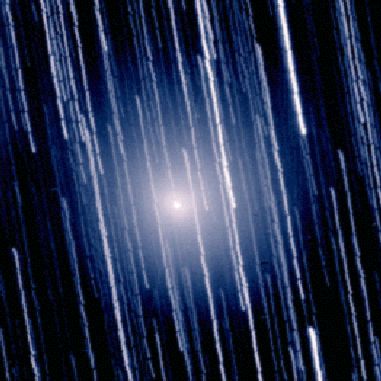
|
Credit & Copyright: T. Puckett
(Puckett Observatory)
Explanation:
Star trails
streak this composite time exposure of
comet
Tempel-Tuttle recorded by Tim Puckett on January 26, 1998.
Then passing through the inner solar system on its
33 year orbit around the Sun,
Tempel-Tuttle brightened unexpectedly, but
binoculars or small telescopes
were still required to visually observe it.
Tempel-Tuttle is also called "the Leonid Comet" as the yearly
Leonid meteor shower
results when the Earth crosses this comet's orbital
plane and encounters a trail of
cometary dust.
So, while not rivaling spectacular naked-eye comets like
Hyakutake or
Hale-Bopp,
Tempel-Tuttle still puts on a show.
The Earth is
now approaching relatively
dense regions
of Tempel-Tuttle's orbiting debris trail, so
in the next few days,
skywatchers will be
searching for leonid meteors.
An extremely active meteor shower
is expected to be visible
over Europe and North America
in the early morning hours of
Tuesday, November 19,
despite interference from a glaring full moon.
|
January February March April May June July August September October November December |
| ||||||||||||||||||||||||||||||||||||||||||||||||
NASA Web Site Statements, Warnings, and Disclaimers
NASA Official: Jay Norris. Specific rights apply.
A service of: LHEA at NASA / GSFC
& Michigan Tech. U.
Based on Astronomy Picture
Of the Day
Publications with keywords: comet Tempel-Tuttle - comet - meteor shower - Leonids
Publications with words: comet Tempel-Tuttle - comet - meteor shower - Leonids
See also:
- APOD: 2025 September 30 Á Comet Lemmon Brightens
- APOD: 2025 September 29 Á Two Camera Comets in One Sky
- APOD: 2025 September 26 Á A SWAN an ATLAS and Mars
- APOD: 2025 September 18 Á Comet C/2025 R2 SWAN
- APOD: 2025 September 16 Á New Comet SWAN25B over Mexico
- APOD: 2025 August 2 Á Fireflies, Meteors, and Milky Way
- APOD: 2025 July 25 Á Twelve Years of Kappa Cygnids
